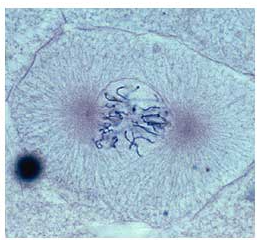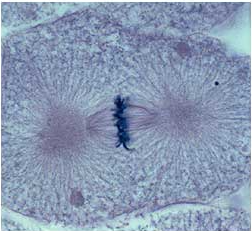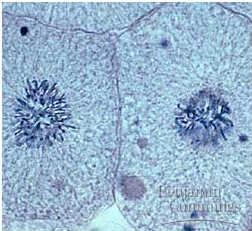2.6-Cell Division and Diversity (copy)
1/33
There's no tags or description
Looks like no tags are added yet.
Name | Mastery | Learn | Test | Matching | Spaced |
|---|
No study sessions yet.
34 Terms
what is the purpose of mitosis
growth and repair of tissues
the cell cycle
G1-first growth phase
S- Synthesis phase
G2-second growth phase
M-mitotic phase
G1- Growth Phase
cell prepares to replicate DNA by synthesising mRNAs and proteins required to execute further steps
cell grows larger, organelles are copied
S- Synthesis phase
all genetic information is copied by DNA replication
Process generates sister chromatids
sister chromatids
identical pairs of chromosomes attached to each other by a centromere
centromere
specialised sequence of DNA that links sister chromatids and is important throughout mitosis
G2- Growth Phase
cell undergoes additional growth, replenishes energy stores and prepares and reorganises cytoplasmic components for division
some organelles duplicated
cytoskeleton dismantled
Stages of Mitosis
Prophase
Metaphase
Anaphase
Telophase
Prophase
chromosomes condense
nuclear envelope breaks down
organelles break up and move towards edges
mitotic spindle (made of microtubules) forms- extend from pole to pole

Metaphase
mitotic spindle facilitates movement of chromosomes
align along centre of cell - metaphase plate
sister chromatids still attached to each other
Spindle Checkpoint-ensures anaphase won’t proceed until all chromosomes are at metaphase plate and microtubules by kinetochore

Anaphase
when chromosomes are properly aligned, anaphase proceeds
sister chromatids separate at centromere- pulled to edge of cell
now chromosomes

Telophase
spindle disappears
new nuclear envelope forms around chromosomes
chromosomes decondense
cytokinesis occurs

Cytokinesis in Plant Cells
dividing plant cells create a structure known as a cell plate
made of vesicles containing plasma membrane and cell wall components
cell plate enlarges until it merges with cell walls
divides cell in two and allows cell wall to be regenerated
Stages of Meiosis
prophase I
DNA condenses into chromosomes- consists of 2 sister chromatids joined by centromere
chromosomes arranged side by side in homologous pairs- bivalents
centrioles migrate to poles to form spindle
nuclear envelope breaks down and nucleolus disintegrates
Metaphase I
bivalents line up along equator of the spindle
maternal and paternal chromosomes position themselves independently of the others- independent assortment
Anaphase I
homologous pairs are separated as microtubules pull whole chromosomes to opposite ends of the spindle
Telophase I
chromosomes arrive at opposite poles
spindle fibres break down
nuclear envelopes form around two groups of chromosomes and nucleoli reform
Cytokinesis
cytoplasm divides- organelles distributed and cell surface membrane pinches inwards
Prophase II
nuclear envelope breaks down and chromosomes condense
spindle forms perpendicular to old one
Metaphase II
chromosomes line up in a single file along the equator
Anaphase II
centromeres divide and individual chromatids are pulled to opposite poles
four groups of chromosomes with half the number of chromosomes as original
Telophase II
nuclear membranes form around each group of chromosomes
Cytokinesis
cytoplasm divides to create 4 haploid cells
crossing over
process by which non-sister chromatids exchange alleles
results in new combination of alleles on the two chromosomes
process of crossing over
homologous chromosomes pair up and are close to each other
non-sister chromatids cross over at chiasmata and get entangled
entanglement places stress on DNA molecules, so a section of chromatid from one chromosome may break and re-join with chromatid from another chromosome
independent assortment
production of different combinations of alleles in daughter cells due to random alignment of homologous pairs along the equator
the process of independent assortment
in prophase 1, homologous chromosomes pair up and in metaphase 1 they are pulled towards to equator of the spindle
each pair can be arranged with either chromosome on top- random
orientation of one homologous pair is independent by the orientation of another pair
homologous chromosomes are separated and pulled apart to different poles
calculating combinations of chromosomes
2n
n →haploid number of chromosomes
for a zygote:
22n
function and adaptations of erythrocytes
function→ carry oxygen for respiration around the body
biconcave shape- increase SA:V= higher rate of diffusion
small diameter- large SA:V ratio
flexible cytoskeleton → can change shape to fit through capillaries
no nucleus, mitochondria, ER, little cytoplasm→ more space for haemoglobin
function and adaptations of neutrophils
function→ destroy pathogens through phagocytosis and enzyme secretion
twice the size of erythrocytes→ stay in bloodstream
multilobed nucleus→ caused by flexible nuclear membrane- helps cell penetrate cell junctions
flexible→ allows to engulf and destroy pathogens
move via chemotaxis→ directed migration of cells towards a chemoattractant
function and adaptations of sperm cells
function- reproduction→ fertilise an egg in order to initiate development of an embryo
nucleus in head has half the number of chromosomes (haploid)
acrosome in head contains digestive enzymes→ break down outer layer of egg cell
lots of mitochondria- release energy through respiration for tail movement
has tail which rotates to propel the cell forwards
function and adaptations of root hair cells
function→ absorb water and mineral ions from soil
root hair increases SA- higher rate of osmosis
thinner walls- shorter diffusion path
permanent vacuole contains concentrated cell sap- maintains water potential gradient
lots of mitochondria- energy for active transport
no chloroplasts
structure and function of ciliated epithelium
function- move substances across surface of tissue
have cilia which beat in a coordinated way to shift material along the surface of epithelium tissue
goblet cells secrete mucus- helps trap dust, microorganisms etc
function and adaptations of squamous epithelium
function- provide a surface covering or outer layer e.g. in alveoli, blood vessels
single layer of flattened cells on basement membranes
thin cross section- short diffusion pathway
permeable- easy diffusion of gases
function and adaptations of palisade cells
function- carry out photosynthesis to produce glucose and oxygen
large number of chloroplasts- more light absorption for photosynthesis
tall and thin shape- allows light to penetrate deeper before encountering another cell wall, also means cells can be densely packed together
function and adaptations of guard cells
function→ control opening of stomata to regulate water loss and gas exchange
inner cell walls thicker (facing air outside leaf) and outer cell walls thinner (facing adjacent cells)- difference in thickness allows cell to bend when turgid
cytoplasm has high density of chloroplasts and mitochondria
what is a stem cell
a cell that can divide by mitosis to differentiate into a specialised cell
ability to differentiate→ potency
types of potency
totipotency→ can differentiate into any cell type found in an embryo, as well as extra-embryonic cells
pluripotency→ can differentiate into any cell found in an embryo
multipotency→ adult stem cells
development of erythrocytes
formed from bone marrow stem cells:
multipotent cell divides to form proerythrocytes
changes have occurred therefore cell can only form erythrocyte
haemoglobin builds up in cytoplasm
nucleus is ejected
further changes (e.g. haemoglobin, biconcave) develop to form a mature erythrocyte
development of neutrophils
formed from multipotent stem cells in bone marrow
indentations in nucleus form→ lobed structure
granules accumulate→ lysosomes containing enzymes
the development of xylem and phloem
in roots and stems, stem cells at inner edge of cambium differentiate into xylem and cells at outer edge differentiate into phloem
cambium cells that differentiate to form xylem lose cytoplasm, deposit lignin in cell walls and lose end walls
cambium cells that differentiate into phloem lose some of their cytoplasm and organelles, develop sieve plates at ends of cells
use of embryonic stem cells in medicine
stem cells used in therapeutic treatment of disease due to ability to differentiate
can treat diseases e.g. Alzheimer’s, Parkinson’s
embryos used are often waste embryos from IVF
have potential to develop into human beings→ ethical objections
use of multipotent adult stem cells in medicine
research is being done to see if adult stem cells can be used to treat disease e.g. leukemia, and injuries e.g. skin burns
less controversial than embryonic→ donor can give permission
need to be close match to bloody type and antigens etc→ risk of rejection